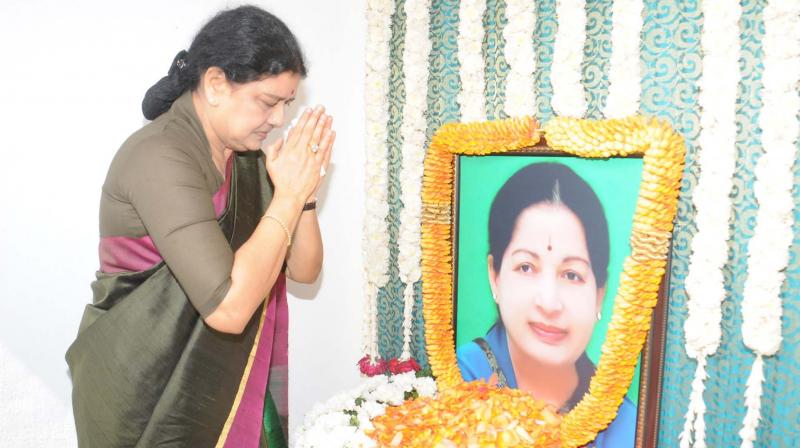Sasikala's rise reflects sea change in TN leadership profile

Chennai: From leadership of the party to heading the AIADMK government in Tamil Nadu may be an uphill task for Ms V K Sasikala, close confidante of the late Chief Minister J Jayalalithaa following her recent elevation as the Dravidian party’s general secretary, even if formalisation of that position within the AIADMK might take some more time.
However, as the 62-year-old Sasikala stepped into Jayalalithaa’s shoes as the AIADMK supremo on Friday, one signal was unmistakable, amid the huge advantage Amma’s former aide for 33 years has been having in a new round of political tussle.
It is often said there is always room at the top in politics. Notwithstanding the vicissitudes of power struggles, Sasikala’s rise in the post-Jayalalithaa phase signals a sea change in the profile of political leadership in the Sate, right from the 1920s’ when the first limited election to Legislative Council of the erstwhile Madras Presidency was held.
A quick look at the historical trend is a fascinating read. In the beginning, it was the heydays of the now defunct Justice Party that implemented the social and political agenda of the ‘Non-Brahmin Movement’, which itself was a reaction to the perceived ‘Brahmin domination’ in education and services under then British rule.
The top leadership of the Justice Party, which ruled the erstwhile Madras Presidency until 1937, when Congress for the first time came to power after the first election to the then new Provincial Assembly created under the ‘1935 GOI Act’, were all mostly from the landed aristocratic gentry, wealthy bankers or established professionals, mainly lawyers, or hailing from esteemed ‘service families’, those who held good positions under the Raj.
A few examples would illustrate this point: Take the Raja of Panagal, who was the Chief Minister (they were called Premiers then) of the province from 1921-26. He hailed from what historians say was a “prestigious Velama Zamindari family connected to Sri Kalahasthi (now in Andhra Pradesh)”. Or even the Raja of Bobbili for that matter, who was Chief Minister from 1932-36, was from a leading ‘Velama Zamindari family’.
Many of the leading lights/backers of the Justice Party like Raja Sir Annamalai Chettiyar, Ponnambala Tyaga Rajan of Madurai (late Assembly speaker P T R Palanivel Rajan’s father), Dr C Natesan, Arcot Ramaswamy Mudaliar, who edited the highly respected journal ‘Justice’, Dr P Subbaroyan, the Zamindar of Kumaramangalam near Salem (until he joined the Congress in 1935), and A Subbarayalu Reddiar, were all from a similar background, coming from families with good endowments, socially and economically.
Even Ramaswamy Naicker, more famously known as Periyar, leader of the rationalist/ Self-Respect Movement, who took forward the legacy of the Justice Party in the form of ‘Dravidar Kazhagam (DK)’, was from a leading family of merchants in Erode.
It was the Congress leadership in Tamil Nadu emerging since the mid-1930s’ saw a relatively less wealthy group of lawyers-turned-politicians like Satyamurthy and Rajaji slowly getting to be politically influential. In fact one of them K Kamaraj, who later rose to become Chief Minister of Tamil Nadu and All India Congress President after Independence, hailed from a poor ‘Nadar’ community family, like many others inspired by Mahatma Gandhi’s non-violent ‘Satyagrahas’, as part of the freedom struggle.
Thus, the emergence of the Congress after defeating the Justice Party in the 1937 Assembly elections, as historians have shown, spawned a new generation of political leadership even if several in the Congress had landed aristocratic roots. As more common voters came into the electoral process, the Congress’ leadership profile also underwent a big change, even attire reflecting ‘Swadeshi’ values of simplicity, led by Gandhi himself.
Some of the Left leaders in the State, like the CPI veteran R. Nallakannu, were influenced by both Gandhi, poet Subrahmanya Bharathi and Marx.
Later, with the rise of the DMK, which under the leadership of the ‘political genius’ late C N Annadurai had broken away from their parent Periyar’s DK party, in the mid-1960s’, the leadership profile again underwent a radical change.
The core DMK leadership led by Anna came from a young band of fiery student leaders with high proficiency in Tamil language, besides Tamil professors and scholars. Whether it was the late E.V.K. Sampath, the nonagenarian Constitutional pundit Era Sezhiyan, the late brilliant Tamil scholar and veteran Finance Minister, V R Nedunchezhian, or Prof. K Anbazhagan, the DMK general secretary, they all represented a new politically critical Tamil elite mass.
But in parallel, a host of powerful ‘ideological message-bearers’ of the Dravidian Movement from the world of theatre and cinema, most notably the legendary script-writer and orator M Karunanidhi, and late actor-turned politician M G Ramachandran, were already giving DMK’s top leadership a mixed profile, at times a point of conflict between the ‘intellectuals’ within the party and the popular crowd-pulling individuals.
Post-Annadurai’s untimely demise in 1969, almost for two decades till 1987, Tamil Nadu politics was dominated by a polarization behind the two such leaders Karunanidhi and MGR, who enjoyed a cult-like status among the major Dravidian parties’ middle class, lower middle class and poorer section electorates.
If MGR’s wife, Janaki Ramachandran lost out in the leadership succession battle, the highly articulate, versatile film artiste-turned politician Jayalalithaa Jayaram, groomed by MGR, was a huge success in carrying forward that charismatic leadership style as leader of the AIADMK. That marked what may be called a third phase in the making of political leadership in Tamil Nadu.
It is amid this huge backdrop of complex historical trends, Ms Sasikala’s bid now to be ‘Amma’s successor in the State politics, begins to unveil a new leadership profile. People like Ms. Sasikala speak for the OBCs’ in Tamil Nadu fully coming onto their own.

